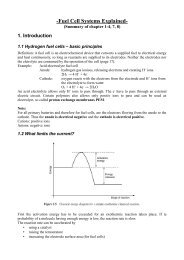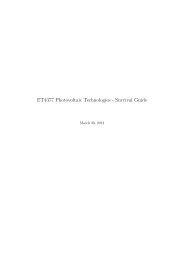Fuel Cell Systems Explained - from and for SET students
Fuel Cell Systems Explained - from and for SET students
Fuel Cell Systems Explained - from and for SET students
You also want an ePaper? Increase the reach of your titles
YUMPU automatically turns print PDFs into web optimized ePapers that Google loves.
4.4 Water management in the PEMFCWtaer management is a crucial aspect in designing a PEMFC. The PEM requires a sufficient watercontent, the proton conductivity is directly proportional to it. On the other side, should theelectrodes <strong>and</strong> the gas diffusion layer not be flooded <strong>and</strong> blocked. In an ideal case, the productwater would diffuse evenly through the electrolyte <strong>and</strong> keep it at a correct level of hydration.But there are several complications: Electro-osmotic dragH + moving <strong>from</strong> anode to cathode, drag H 2 O with them, especially at high current densities. Theanode side of the PEM can dry out. Drying effect of air at high temperaturesAt approximatly 60°C the air will always dry out the elctrodes faster than H 2 O is produced.Solution: Humidify the reactants be<strong>for</strong>e entering the fuel cell. Correct water balance throughout the whole cellDry air may ente the cell, but it can become saturated in the cell <strong>and</strong> can not dry off any moreexcess water. Important <strong>for</strong> designing larger stacks.Fortunately, all water movements are predictable <strong>and</strong> controllable. Water production <strong>and</strong> water dragare directly proportional to the current. The water evaporation can be predicted. The back diffusionof water <strong>from</strong> cathode to anode depends on the thickness of th PEM <strong>and</strong> the relative humidity ofeach side. The preceded external of humidification of the reactants is also controllable.4.4.2 Air flow <strong>and</strong> water evaporationIn a PEMFC it is common to remove the product water by the air flow through the cell (expect thespecial case: using pure O 2 ). That means, that air is always fed at an higher rate into the cell, thanneeded to provide the O 2 <strong>for</strong> the reactions (> stoichiometric rate). In practice, the stoichiometry λwill be at least 2.Problems arise because the drying effect of air is highly non-linear in relation to the temperature.The amount of water vapour in air varies greatly, depending on temperature, location, weatherconditions <strong>and</strong> other factors. One way of describing it is the humidity ratio, the ratio of watervapour in respect to the other gases in air, also called absolute humidity or specific humidity.ω = m w / m awith m w : mass of waterm a : mass of dry airThe relative humidity of air gives a good impression of the drying effect of air <strong>and</strong> is defined asΦ = P w / P satwith P w : partial pressure of waterP sat : saturated vapour pressure (the air is fully humiditied, it can not hold any more water)The problem in case of a fuel cell is, that P sat varies with temperature in a highly non-linear way. Itincreases more rapidly with incresing temperature.






